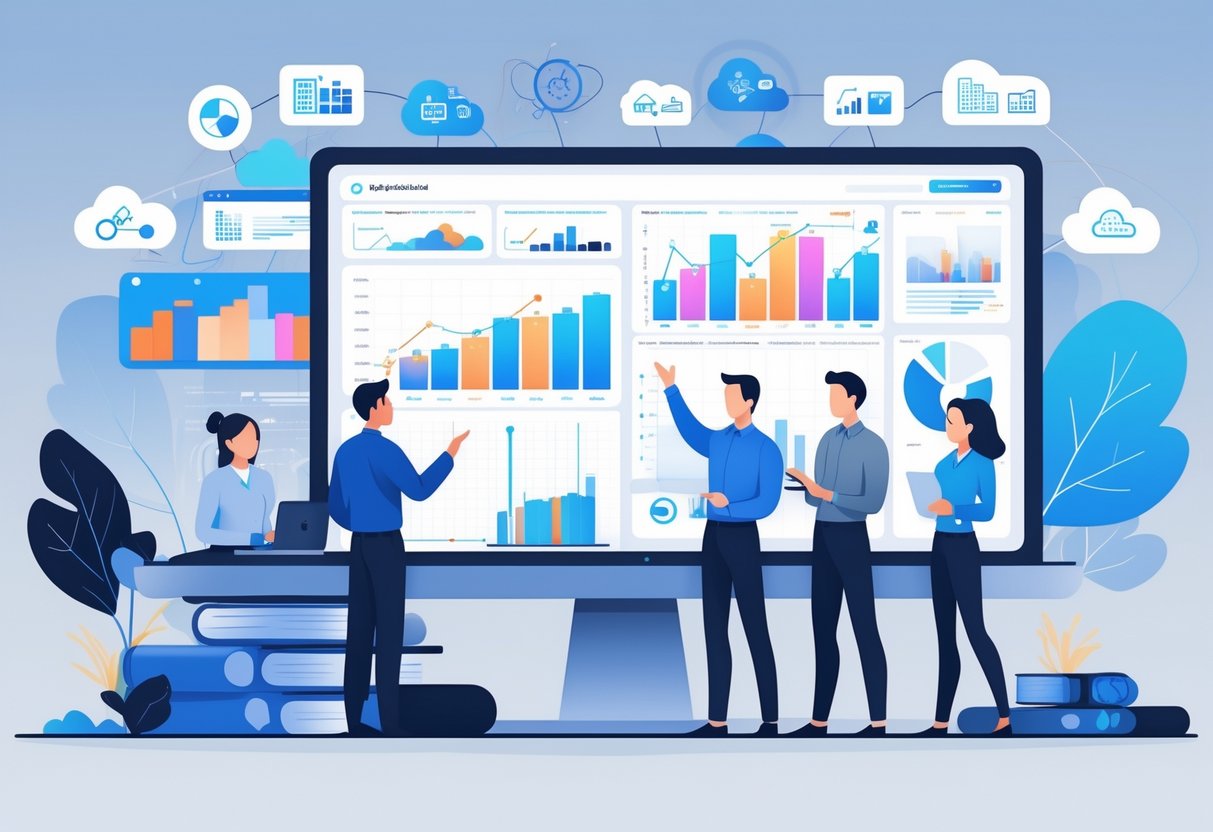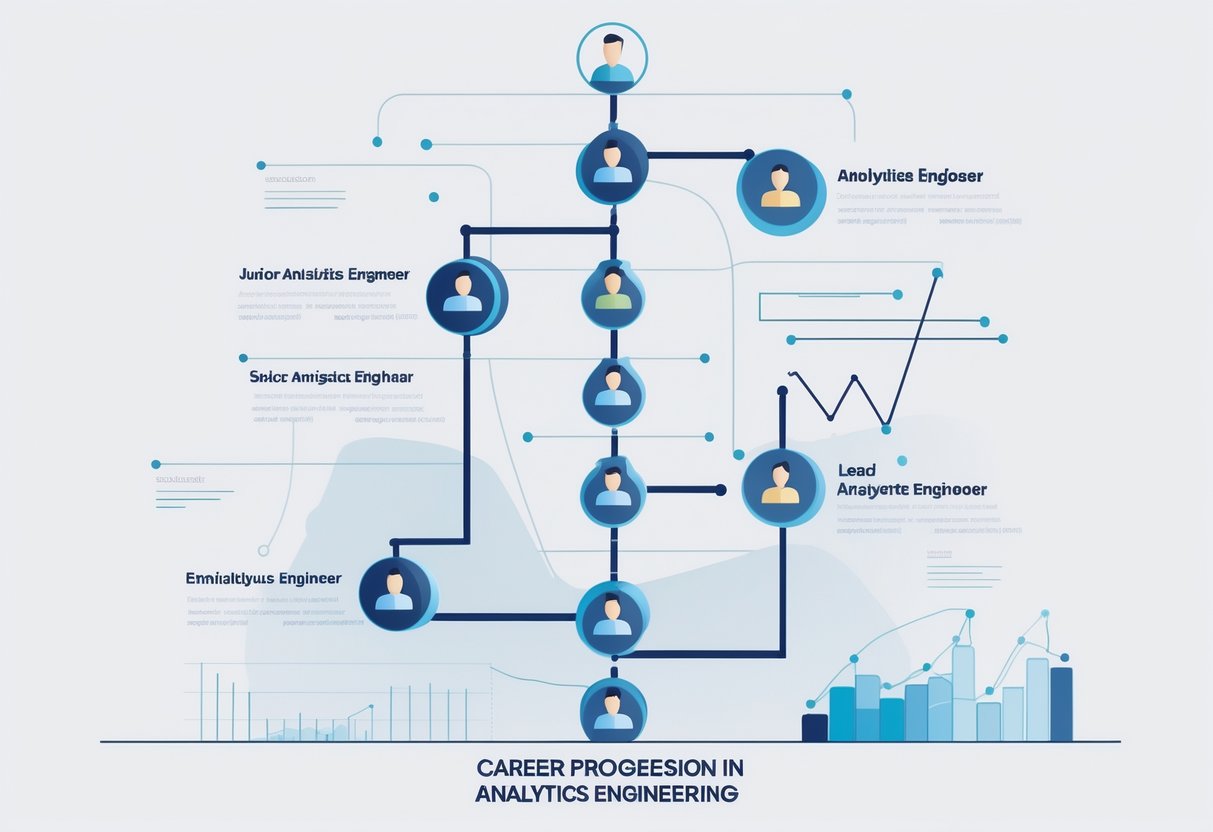The analytics engineering field has grown rapidly, creating a confusing mix of job titles that often overlap or mean different things at different companies.
Analytics engineers bridge the gap between data analysts and data engineers, focusing on transforming raw data into reliable, accessible insights for business teams.
Understanding these roles helps professionals navigate career paths and employers find the right talent.

Analytics engineering job titles range from entry-level positions like Data Analyst and Junior Analytics Engineer to senior roles such as Director of Analytics and Chief Data Officer.
Each title comes with specific responsibilities, required skills, and salary expectations.
The field includes technical roles focused on building data pipelines alongside business-oriented positions that translate data into strategic decisions.
Companies use different naming conventions for similar roles, making it essential to look beyond job titles to understand actual responsibilities.
Some organizations call their analytics engineers “Data Engineers” while others use “Business Intelligence Analysts” for similar work.
This guide breaks down the most common titles, explains what each role actually does, and shows how professionals can advance their careers in this growing field.
Key Takeaways
- Analytics engineers combine technical data skills with business knowledge to create reliable data systems for decision-making.
- Job titles in analytics engineering vary widely between companies, so understanding actual responsibilities matters more than the specific title.
- Career progression typically moves from analyst roles through senior engineering positions to management and executive data leadership roles.
Core Analytics Engineering Job Titles

These positions form the backbone of data teams, focusing on building reliable data pipelines and creating scalable data models.
Each role carries distinct responsibilities from hands-on technical work to strategic team leadership.
Analytics Engineer
An analytics engineer bridges the gap between data analysts and data engineers, focusing on transforming raw data into business-ready insights.
They spend most of their time building and maintaining data models using tools like dbt.
Key Responsibilities:
- Building data pipelines from source systems to data warehouse
- Creating documentation for data models and transformations
- Writing SQL queries and dbt models for data transformation
- Testing data quality and ensuring accuracy
Analytics engineers work closely with data analysts to understand business requirements.
They translate these needs into technical solutions within the data warehouse.
The role requires strong SQL skills and familiarity with modern data stack tools.
Most analytics engineers use version control systems like Git to manage their code.
They often serve as the primary contact between technical data teams and business stakeholders.
This position typically requires 1-3 years of data experience.
Analytics Engineering Lead
An analytics engineering lead guides technical direction while maintaining hands-on involvement in data modeling projects.
They mentor junior team members and establish best practices for the analytics engineering function.
Primary Duties:
- Technical Leadership: Setting standards for dbt projects and data pipeline architecture
- Code Review: Ensuring quality and consistency across all data models
- Project Planning: Breaking down complex analytics initiatives into manageable tasks
- Mentorship: Training junior analytics engineers on tools and methodologies
Lead analytics engineers often participate in architecture decisions for the data warehouse.
They evaluate new tools and technologies that could improve team productivity.
They collaborate with data engineering teams to optimize data pipeline performance.
Documentation becomes a key focus area, ensuring all team processes are well-documented.
This role typically requires 3-5 years of analytics engineering experience.
Strong communication skills are essential for cross-team collaboration.
Senior Analytics Engineer
Senior analytics engineers tackle the most complex data modeling challenges and drive innovation within data teams.
They design scalable solutions that support enterprise-wide analytics needs.
Core Functions:
- Architecting complex data models spanning multiple business domains
- Optimizing data warehouse performance and query efficiency
- Leading technical discussions about data architecture decisions
- Building frameworks and templates for other team members
They often specialize in specific areas like customer analytics or financial reporting.
Senior analytics engineers frequently interface with executive stakeholders to understand strategic data requirements.
These professionals evaluate and implement new technologies within the modern data stack.
They establish testing frameworks to ensure data quality at scale.
Senior analytics engineers typically mentor other team members and participate in hiring decisions.
They contribute to company-wide data governance initiatives.
This position usually requires 5+ years of experience with data modeling and analytics engineering tools.
Analytics Engineering Manager
An analytics engineering manager oversees the team while balancing technical strategy with people management.
They ensure the analytics engineering function delivers value to the broader organization.
Management Responsibilities:
- Team Development: Hiring, training, and career development for analytics engineers
- Resource Planning: Allocating team capacity across competing business priorities
- Stakeholder Communication: Reporting progress and challenges to senior leadership
- Technical Strategy: Setting long-term direction for data modeling and pipeline architecture
They work closely with other data team managers to coordinate efforts across functions.
Analytics engineering managers often participate in budget planning for tools and infrastructure.
These managers establish processes for documentation, code review, and project delivery.
They measure team performance using metrics like data pipeline reliability and model deployment frequency.
The role requires both technical depth in analytics engineering and strong leadership skills.
Most managers have 7+ years of experience with at least 2 years in leadership roles.
Key Differences Between Data Roles

Analytics engineers work closely with data analysts, data engineers, and data scientists but have distinct responsibilities.
They focus on data modeling and transformation while other roles handle analysis, infrastructure, or advanced machine learning tasks.
Analytics Engineer vs Data Analyst
Data analysts focus on analyzing data and creating reports for business stakeholders.
They spend most of their time in tools like Excel, Tableau, and Power BI to build dashboards and visualizations.
Analytics engineers take a different approach.
They work behind the scenes to prepare clean, organized data that analysts can use more effectively.
Key Technical Differences:
- Data analysts use SQL for basic queries and rely heavily on business intelligence tools
- Analytics engineers write complex SQL transformations and use advanced data modeling techniques
- Data visualization is a core skill for analysts, while engineers focus on data structure
The relationship between data analysts and analytics engineers shows how engineers enable analysts to work faster.
Analytics engineers create standardized data models that multiple analysts can use across different projects.
Data quality becomes much better when analytics engineers handle transformations.
Analysts can then focus on finding insights instead of cleaning messy data.
Analytics Engineer vs Data Engineer
Data engineers build the basic infrastructure that moves data from different sources into data warehouses.
They create pipelines that extract, transform, and load raw data from APIs and databases.
Analytics engineers work with the data that engineers have already collected.
They focus on making this data ready for business analysis rather than building the initial pipelines.
Scope Differences:
- Data engineers handle custom APIs and complex ETL processes
- Analytics engineers work mainly with vendor APIs like Google Analytics
- Python is essential for data engineers, while analytics engineers use it less frequently
The technical skills overlap between these roles can cause confusion.
Both use SQL and work with cloud platforms, but engineers focus more on infrastructure.
Data engineers typically work with bigger, more complex data sources.
Analytics engineers concentrate on transforming business data that the data team will use for reporting and analysis.
Analytics Engineer vs Data Scientist
Data scientists investigate data to find patterns and build machine learning models.
They use Python and advanced statistical methods to solve complex business problems and make predictions.
Analytics engineers support data scientists by providing clean, well-structured datasets.
This allows scientists to spend more time on analysis instead of data preparation.
Primary Focus Areas:
- Data scientists build predictive models and run experiments
- Analytics engineers create reliable data foundations for analysis
- Machine learning is central to data science but not part of analytics engineering
Data scientists need deep knowledge of statistics and algorithms.
Analytics engineers focus more on data modeling and ensuring consistent data quality across the data team.
The collaboration works well because scientists can trust that analytics engineers have already handled data validation and transformation.
This separation lets each role focus on their strengths without overlap.
Essential Skills and Tools for Analytics Engineering

Analytics engineers need a mix of technical programming skills, data modeling expertise, visualization abilities, and strong documentation practices.
Strong SQL skills are vital for handling and transforming raw data, while modern tools like dbt and cloud platforms enable scalable data solutions.
SQL and Programming Languages
SQL forms the foundation of analytics engineering work.
Analytics engineers write complex queries to transform raw data into clean, structured formats that business users can understand.
Core SQL Skills:
- Advanced joins and window functions
- Data transformation and aggregation
- Performance optimization techniques
- Database-specific syntax variations
Python serves as the primary programming language for data processing tasks.
Analytics engineers use Python libraries like pandas and NumPy for data manipulation outside of SQL environments.
Java and Scala become important when working with big data frameworks.
These languages handle large-scale data processing in distributed systems like Apache Spark.
Excel remains relevant for quick analysis and stakeholder communication.
Many analytics engineers use Excel to prototype models before building them in more robust systems.
Data Modeling and Warehousing
Analytics engineers focus on transforming, testing, and deploying analytics code while building data pipelines and implementing data models.
They design logical data structures that reflect business processes and relationships.
Key Modeling Concepts:
- Dimensional modeling (star and snowflake schemas)
- Data normalization and denormalization
- Slowly changing dimensions
- Fact and dimension table design
dbt (data build tool) has become the standard for modern data transformation.
Analytics engineers write SQL-based models that dbt compiles and executes in the data warehouse.
Snowflake represents one of the leading cloud data warehouse platforms.
Analytics engineers configure Snowflake environments, manage compute resources, and optimize query performance.
Data warehouse architecture knowledge helps analytics engineers design scalable solutions.
They understand how different storage formats and partitioning strategies affect query performance.
Data Visualization Platforms
Analytics engineers create dashboards and reports that translate complex data into business insights.
They work closely with stakeholders to understand reporting requirements and design effective visualizations.
Tableau offers powerful data visualization capabilities.
Analytics engineers build Tableau dashboards that connect directly to data warehouses and update automatically as new data arrives.
Tableau Skills Include:
- Calculated fields and parameters
- Dashboard design principles
- Data source connections
- Performance optimization
Power BI provides Microsoft-integrated analytics solutions.
Many organizations choose Power BI for its seamless integration with existing Microsoft tools and services.
Analytics engineers select appropriate chart types and visualization techniques based on the data story they want to tell.
They understand when to use bar charts, line graphs, heat maps, and other visualization formats.
Version Control and Documentation
Git enables analytics engineers to track changes in their code and collaborate with team members.
They use branching strategies to manage development workflows and code reviews.
Version Control Practices:
- Branch management and merging
- Commit message standards
- Pull request workflows
- Code review processes
Documentation ensures that data models and business logic remain understandable over time.
Analytics engineers write clear explanations of their transformation logic and data lineage.
They document data definitions, business rules, and calculation methods.
This documentation helps other team members understand and maintain existing analytics solutions.
Analytics engineers also maintain data dictionaries that explain field meanings and data sources.
These resources help business users interpret reports and dashboards correctly.
Career Progression and Related Job Titles

Analytics engineering careers follow several distinct paths, with professionals often transitioning between data science, data engineering, and business analytics roles.
The field continues to evolve with new hybrid positions that combine traditional engineering skills with machine learning and business intelligence expertise.
Common Analytics Engineering Career Paths
Analytics engineers typically start as junior data analysts or entry-level data engineering specialists.
They learn SQL, Python, and basic data transformation tools during their first year.
Mid-level professionals advance to senior analytics engineer roles.
They focus on building data pipelines and creating models for predictive analytics and descriptive analytics.
Many professionals transition into data science positions after gaining experience.
Others move toward machine learning engineer roles that require deeper technical skills.
Software engineer backgrounds provide strong foundations for analytics engineering careers.
These professionals already understand coding principles and system architecture.
Senior-level positions include lead analytics engineer and principal data engineer.
These roles involve managing teams and designing complex data systems for big data processing.
Executive paths lead to roles like Chief Data Officer or VP of Analytics.
These positions focus on strategy rather than hands-on technical work.
Emerging and Hybrid Data Roles
New positions combine analytics engineering with specialized skills. Machine learning engineer roles now require both data pipeline expertise and model deployment knowledge.
Data platform engineers focus on infrastructure for business analytics systems. They build tools that support both data analytics teams and business users.
Analytics consultants help companies implement Google Analytics and other tracking systems. They bridge the gap between technical implementation and business needs.
Product analytics engineers work directly with product teams. They create metrics and dashboards that drive product decisions through data mining techniques.
Data science platform engineers build tools for data scientists. They create environments where machine learning models can be developed and deployed efficiently.
Industry Trends in Analytics Engineering
Companies increasingly value professionals who understand both technical systems and business needs. Business analytics knowledge becomes essential for career advancement.
Remote work has expanded job opportunities across different geographic markets. Many analytics engineering positions now offer flexible work arrangements.
Cloud platforms drive demand for engineers with AWS, Azure, and Google Cloud skills. Traditional on-premise data systems are becoming less common.
Real-time analytics creates new job categories. Engineers who can build streaming data pipelines command higher salaries than those focused only on batch processing.
Data engineering job titles continue to evolve as companies define new roles.
Organizations create custom titles that reflect their specific technology stacks and business requirements.
Frequently Asked Questions
Analytics engineering professionals often have questions about role definitions, career paths, and compensation structures. These common inquiries cover everything from daily responsibilities to salary expectations and career transitions.
What are the typical roles and responsibilities of an Analytics Engineer?
An Analytics Engineer bridges the gap between data engineering and data analysis, focusing on transforming, testing, and deploying analytics code. They work with large datasets to create reports, dashboards, and visualizations that inform business decisions.
Analytics Engineers are responsible for curating data models and ensuring data quality. They build scalable and efficient data pipelines that enable analysts and business users to access reliable information.
The role involves collaborating with cross-functional teams to translate data insights into actionable business strategies. Analytics Engineers also focus on implementing reporting frameworks and developing dashboards that empower organizations to make informed decisions.
They ensure data flows smoothly from source to destination. This technical work supports the broader analytics team and business intelligence efforts across the organization.
For hands-on practice and exercises, visit our analytics engineering exercises and premium projects sections.
How does the position of Analytics Engineer differ from a Data Engineer?
Data Engineers work on the databases and infrastructure that other analytics team members use to get information to stakeholders. They focus on bringing data from business systems into data warehouses in an accurate, timely, and secure fashion.
Analytics Engineers take a different approach by working more closely with the business side. They focus on turning data into actionable insights rather than just managing the technical infrastructure.
Data Engineers concentrate on building and maintaining the technical foundation for data processing. Analytics Engineers use this foundation to create models and reports that directly support business decisions.
The Analytics Engineer role combines technical skills with business understanding. This hybrid approach allows them to bridge the gap between raw data infrastructure and practical business applications.
What is the career progression path for Analytics Engineers?
Analytics Engineers can advance through several career levels, starting from junior positions and moving into senior technical roles or management positions. The progression typically follows a structured hierarchy with clear advancement opportunities.
Entry-level professionals often start as Data Analysts or Junior Analytics Engineers. They gain experience working with datasets and learning analytical tools before advancing to full Analytics Engineer positions.
Mid-level progression leads to Senior Analytics Engineer roles. These positions involve leading analytics projects, designing complex data systems, and mentoring junior staff members.
Leadership tracks include Analytics Engineering Manager and Director of Analytics positions. These roles focus on team management, strategic planning, and aligning data initiatives with business objectives.
Executive-level positions include VP of Analytics and Chief Data Officer roles. These positions involve setting organizational data strategy and overseeing enterprise-wide data governance initiatives.
Can you outline the various seniority levels within analytics engineering positions?
The Analytics Engineer job title hierarchy includes several distinct levels, each with specific responsibilities and requirements. Junior-level positions include Data Analyst, Analytics Associate, and Business Intelligence Analyst roles.
Mid-level positions encompass Analytics Engineer, Data Engineer, and Business Analytics Consultant titles. These roles require more experience and often involve project leadership responsibilities.
Senior-level positions include Senior Data Analyst, Lead Data Engineer, and Advanced Analytics Consultant roles. Professionals at this level design complex systems and guide strategic initiatives.
Management positions include Analytics Engineering Manager, Data Science Manager, and Manager of Analytics titles. These roles involve team leadership and cross-functional collaboration.
Executive levels feature Director of Analytics, VP of Analytics, and Chief Data Officer positions. These roles focus on organizational strategy and high-level decision making.
What factors influence the salary range for an Analytics Engineer?
Experience level significantly impacts Analytics Engineer compensation packages. Entry-level positions typically offer lower salaries, while senior and executive roles command higher compensation.
Geographic location affects salary ranges due to cost of living differences and local market demand. Major tech hubs often offer higher salaries to attract qualified candidates.
Industry sector influences compensation levels. Financial services, technology, and healthcare industries often pay premium salaries for analytics expertise.
Company size and type affect salary structures. Large corporations and well-funded startups typically offer more competitive compensation packages than smaller organizations.
Technical skills and certifications can increase earning potential. Expertise in specific tools, programming languages, and cloud platforms often leads to higher salaries.
To explore learning paths and practice opportunities, check out our enrollment page or try our games selection.
How does one transition into an analytics engineering role from a related field?
Professionals can transition from data analyst positions by developing stronger technical skills in data modeling and pipeline development. This progression requires learning programming languages and database management systems.
Software engineers can move into analytics engineering by gaining business intelligence knowledge and data analysis skills. They need to understand how to translate technical capabilities into business insights.
Business analysts can transition by developing technical skills in SQL, data warehousing, and analytics tools. This path requires learning how to work with larger datasets and more complex systems.
Data scientists can shift focus toward analytics engineering by emphasizing data pipeline development and business intelligence work. This transition involves less statistical modeling and more infrastructure development.
Database administrators can leverage their technical foundation by learning analytics-specific tools and business intelligence concepts. Their existing data management skills provide a strong foundation for the transition.




